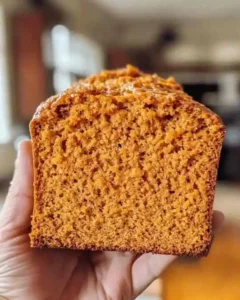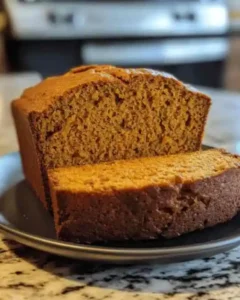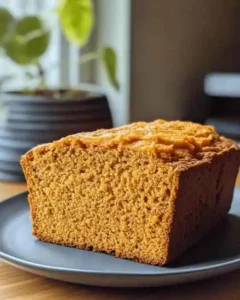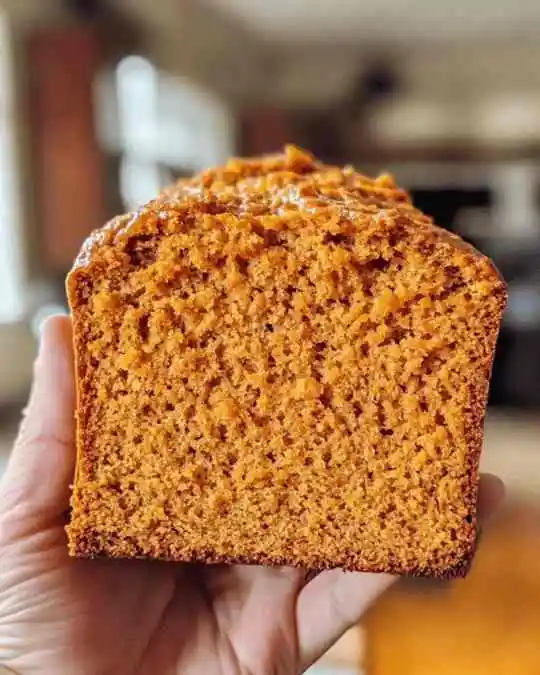This easy sweet potato bread recipe is perfect for fall. It’s rich and warm, making it a comforting treat. Plus, it’s good for you, offering health benefits.
It’s simple to make and has a moist texture. In this guide, you’ll learn what ingredients you need and how to make it. You’ll also get tips to make sure your bread is perfect every time.

Introduction to Sweet Potato Bread
Sweet potato bread is a tasty twist on traditional quick breads. It gets its unique flavor from the natural sweetness of sweet potatoes. This bread started in the southern United States in the late 19th century.
North Carolina is the biggest producer of sweet potatoes in the U.S. In 2020, it produced over 1.5 million pounds. This made a lot of money and boosted its place in food across the country.
The bread is soft and fluffy, great for breakfast or as a snack. One medium sweet potato has a lot of vitamin A, fiber, and potassium. These nutrients make the bread not only tasty but also good for you.
People love the warm, rich taste of potato bread. It’s similar to pumpkin bread, perfect for fall. Making it or enjoying it is a way to celebrate the autumn season.
Why Sweet Potato Bread is a Perfect Fall Treat
Sweet potato bread is a top pick for autumn. It captures the fall flavors everyone loves. It’s also a cozy treat to share with family and friends.
The use of warm spices like cinnamon and nutmeg adds to its taste. These spices mix well with the sweet potatoes, making it a perfect treat for the cold weather.
The aroma of baking sweet potato bread fills the kitchen. It’s a comforting smell that brings everyone together. This recipe has a 5-star rating from five reviews, proving it’s a favorite among bakers. It makes ten generous slices, perfect for sharing.
Baking at 350°F for 50 to 70 minutes makes the warm spices spread throughout. This creates a loaf that’s not just tasty but also a feast for the senses. potato bread is a true fall delight, blending cozy textures with delicious fall flavors in every slice.
Ingredients for Easy Sweet Potato Bread
Making a tasty sweet potato bread starts with picking the right ingredients. This recipe is simple, needing just a few key items. It also lets you add your own twist.
Essential Ingredients
- Sweet Potato Puree: This is the main ingredient, adding flavor and moisture. Choose a high-quality brand for the best taste.
- Self-Rising Flour: It has baking powder and salt already, making it easy. Remember, the flour’s protein content affects how much liquid you need.
- Milk or Milk Substitutes: You can use almond or soy milk to make the recipe fit your diet.
These three ingredients are the base for a healthy sweet potato bread. It’s easy to make and ready in just five minutes.
Optional Add-ins for Flavor and Texture
To make the bread even better, try adding these optional ingredients:
- Chopped Pecans: They add a nice crunch and nutty taste.
- Spices: Cinnamon, nutmeg, or ginger can make the bread taste warmer and more seasonal.
- Dried Fruits: Raisins or cranberries add sweetness and match the sweet potato’s natural flavor.
By mixing these ingredients carefully, you can make different versions of the bread. This makes baking fun and personal.
Step-by-Step Guide to Making Sweet Potato Bread
Baking sweet potato bread is a rewarding experience. It fills the kitchen with wonderful smells. This guide will help you make a delicious homemade loaf. Start by preparing the sweet potatoes, which are key for the right texture and flavor.
After preparing the sweet potatoes, mix the ingredients. This creates a batter that bakes into a perfect bread.
Preparing the Sweet Potatoes
Begin with 1 cup of cooked and mashed sweet potatoes. Peel, boil, or bake them until they’re tender. Then, mash them until smooth.
This mashed sweet potato puree adds moisture and flavor to the bread.
Mixing the Ingredients
Next, mix your ingredients correctly. In a large bowl, whisk together wet ingredients like ½ cup coconut sugar, ½ cup unsweetened plant-based milk, 1 tsp apple cider vinegar, 1 tsp vanilla extract, and ¼ cup almond butter. Make sure they’re well blended.
In another bowl, mix dry ingredients like 2 ½ cups ground oats, 2 tsp baking powder, 2 tsp cinnamon, ½ tsp salt, and ¼ tsp nutmeg if you like. Fold the dry mixture into the wet ingredients gently. Avoid overmixing to prevent a dense loaf.
Make sure the sweet potato puree is evenly mixed. This balances the flavors and textures in the bread. Following these steps will make baking sweet potato bread enjoyable and rewarding.
| Ingredient | Amount |
|---|---|
| Ground Flax | 2 tbsp |
| Water | 6 tbsp |
| Oats (Ground into Flour) | 2 ½ cups |
| Baking Powder | 2 tsp |
| Cinnamon | 2 tsp |
| Salt | ½ tsp |
| Nutmeg (Optional) | ¼ tsp |
| Mashed Sweet Potato Puree | 1 ½ cups |
| Coconut Sugar | ½ cup |
| Unsweetened Plant-Based Milk | ½ cup |
| Apple Cider Vinegar | 1 tsp |
| Vanilla Extract | 1 tsp |
| Almond Butter | ¼ cup |
Baking Your Homemade Sweet Potato Bread
Getting the baking right is key to making delicious sweet potato bread. Knowing the right oven temperature and how to check for doneness is crucial. Here’s a guide to help your potato bread come out perfectly golden and moist.
Oven Temperature and Timing
The best oven temperature for baking sweet potato bread is 350°F (175°C). It usually takes about 25 to 30 minutes to bake. If you’re using a 9×5 loaf pan, it might take around an hour. Following these baking tips for sweet potato bread will help keep its flavor and texture great. Here’s a quick guide on the best baking practices:
| Oven Temperature | Baking Time | Notes |
|---|---|---|
| 350°F (175°C) | 25-30 minutes | Check doneness with a toothpick. |
| 350°F (175°C) | 1 hour (for a 9×5 loaf pan) | Insert a knife to test for readiness. |
Testing for Doneness
To get the perfect texture, checking sweetness bread doneness is key. After baking for the recommended time, stick a toothpick or knife into the bread’s center. If it comes out clean or with a few crumbs, it’s done. If wet batter sticks to the toothpick, it needs more baking time. These exact methods are important to avoid undercooking or overbaking.
Using these methods will make baking sweet potato bread a breeze. You’ll end up with a bread that’s sure to impress everyone at the table.
Variations of Sweet Potato Bread to Try
Trying different sweet potato bread variations can be a fun journey. Bakers can mix and match ingredients to create unique recipes. For example, adding spices like cardamom or vanilla can give the bread a special taste. Nuts like walnuts or pecans add a nice crunch, while chocolate chips make it even more indulgent.
If you’re looking for a healthier option, try gluten-free sweet potato bread. This version is perfect for those with dietary restrictions but still delicious. Using gluten-free flours means everyone can enjoy it. You can also add dried fruits or seeds to make it even healthier and tastier.

Being creative with sweet potatoes can lead to amazing breads. Each new recipe is a chance to find a new favorite. Baking becomes a fun adventure in exploring different flavors.
Storage Tips for Sweet Potato Bread
Keeping storing sweet potato bread fresh is key to its taste and texture. Here are some tips for the best bread preservation:
- Wrap the bread tightly in plastic wrap to keep it moist and fresh.
- Keep it at room temperature for 1-2 days if you plan to eat it soon.
- Refrigeration can keep it fresh for up to a week, but it might change the texture.
- Freezing is great for longer storage; sweet potato bread can stay frozen for 3 months.
Freezing works best if you slice the bread first. Then, wrap each slice in plastic wrap and put them in a freezer bag. This makes defrosting quick and keeps the bread light.
The best way to store homemade bread is to enjoy it for a long time. By following these tips, every slice stays soft and moist. This way, you can enjoy potato bread whenever you want.
Benefits of Including Sweet Potatoes in Your Diet
Sweet potatoes are not just tasty, but they’re also good for you. They’re full of vitamins A, C, potassium, and fiber. These nutrients help keep you healthy and strong.
They’re great for your digestive health because of their fiber. Fiber in sweet potatoes helps your gut bacteria grow. This improves digestion and overall gut health.
Sweet potatoes also have phytochemicals that fight diseases and boost your immune system. Purple sweet potatoes might even stop some cancer cells from growing. They’re full of antioxidants that protect your eyes and fight chronic diseases.
Here are some key nutrients in sweet potatoes:
| Nutrient | Amount per Cup (Baked, with Skin) | % Daily Value |
|---|---|---|
| Calories | 180 | N/A |
| Carbohydrates | 41 grams | N/A |
| Protein | 4 grams | N/A |
| Fat | 0.3 grams | N/A |
| Dietary Fiber | 6.6 grams | 26% |
| Vitamin A | 213% DV | 213% |
| Vitamin C | 44% DV | 44% |
| Potassium | 20% DV | 20% |
Eating sweet potatoes in moderation helps control blood sugar. They have a medium glycemic index, which means they don’t raise blood sugar as fast as white bread. They’re also good for your heart because of their potassium and fiber.

Conclusion
Sweet potato bread is a standout during the fall season. It brings warmth and comfort as the weather gets cooler. It also lets you get creative in the kitchen.
With so many variations and add-ins, you can make it your own. This makes baking potato bread a special part of family traditions and gatherings.
Adding sweet potatoes to the recipe boosts flavor and adds nutrients like vitamin A, vitamin C, and potassium. When you mix in cranberries, the bread becomes a healthy treat. It’s perfect for enjoying now or later.
By baking sweet potato bread, you create memories with your loved ones. It’s more than just food; it’s about sharing moments and making memories. Try making potato bread this season and enjoy the flavors and health benefits it offers.
FAQ
Can Diabetics Eat Sweet Potato Bread?
Yes, diabetics can enjoy sweet potato bread in moderation. Sweet potatoes have a medium glycemic index, meaning they cause a slower rise in blood sugar compared to white bread or potatoes. To make it more diabetic-friendly:
- Use whole-grain or almond flour for added fiber.
- Replace sugar with natural sweeteners like stevia or erythritol.
- Add nuts or seeds to slow carbohydrate absorption.
Why Do You Soak Sweet Potatoes Before Baking?
Soaking sweet potatoes before baking can serve multiple purposes:
- Reduce Starch: Soaking removes excess starch, helping the sweet potatoes bake more evenly.
- Improve Texture: It creates a softer, creamier texture in the final dish.
- Upgrade Flavor: Soaking can also intensify the sweetness by hydrating the natural sugars.
For sweet potato bread, soaking is less critical if you’re mashing the potatoes, but it’s a useful step for consistency.
What Makes Potato Bread Different?
Potato bread differs from regular bread because it uses potatoes or potato flour in the dough. This addition:
- Makes the bread softer and moister.
- Gives it a slightly sweeter flavor.
- Provides more nutrients, including potassium and vitamin C, compared to regular bread.
Sweet potato bread takes this concept further by incorporating sweet potato puree, adding natural sweetness and a vibrant flavor.
Why Did My Sweet Potato Bread Turn Green?
Sweet potato bread turning green can happen due to a natural reaction between baking soda and the chlorogenic acid found in sweet potatoes. This harmless chemical reaction creates a greenish tint but does not affect the taste or safety of the bread. To prevent it:
- Use the correct amount of baking soda.
- Consider adding an acidic ingredient like vinegar to neutralize the reaction.
Will Sweet Potatoes Spike Blood Sugar?
Sweet potatoes have a medium glycemic index and do not spike blood sugar as rapidly as refined carbohydrates like white bread. The fiber in sweet potatoes slows digestion, which helps stabilize blood sugar levels. To further reduce any spike:
- Pair sweet potato dishes with protein or healthy fats.
- Use smaller portions of sweet potatoes in your recipes.
By preparing sweet potato bread with these considerations, it becomes a balanced option for most diets.

